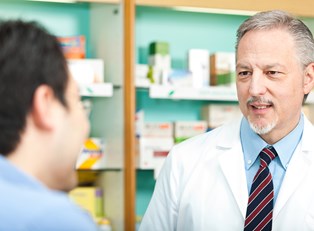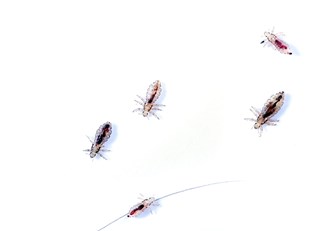The National Institute of Allergy and Infectious Diseases estimates that around 3 million Americans are infected with pubic lice each year. Pubic lice, also known as crabs or crab lice, are commonly classified as a sexually transmitted parasite. However, individuals may become infected in other ways, such as contact with unwashed bedding, clothing, and towels. These parasites aren't known to cause any serious effects on health, but 30% of those with the lice also have another sexually transmitted infection.
Symptoms
Symptoms of pubic lice usually consist of itching in the genital region. Itching may occur throughout the day, but it tends to become more severe at night, when the lice become most active. Upon close inspection with a magnifying glass, infested people will notice eggs attached to pubic hairs as well as hatched lice crawling around.
Scabs and lesions may also be present, which is caused by the feeding behavior of adult lice. The lice bury their heads into the hair follicles in search of blood, resulting in injury to the area around the follicles. Occasionally, symptoms may disappear for a time, leaving the person to believe he or she is no longer infested. However, this is normally because the eggs have not yet hatched. Once they do, symptoms will return and the cycle will begin again.
Despite their name, pubic lice are not always found on the genital region. They may live on the eyelashes and eyebrows as well, though these infestation sites are most prevalent in children. The presence of these kinds of infestations in children can be indicative of sexual abuse. These parasites can also be located on any part of the body with significant hair coverage, such as the chest, back, legs, armpits, and even facial hair.
Differentiating from Other STIs
It's deceptively easy to confuse pubic lice symptoms with those of other sexually transmitted infections, especially early on. Itching in the pubic region can also be a symptom of skin disorders. Scabbing caused by the feeding adult lice may be easily confused with genital herpes, genital warts, or scabies. However, closer inspection will reveal the adult lice and their eggs, which are not present with any other health issue or infection.
Treatment and Prevention
Treatment for pubic lice can be performed by a doctor or in the privacy of your own home using over-the-counter products. Pesticide creams are the most common method used. These have been known to cause serious side effects, although they're generally considered rare and as a consequence of misuse. With that in mind, such treatments may not be appropriate for pregnant or nursing women. Shaving the area is also an effective way of combating infestations.
Prevention of pubic lice is often much simpler than treating them. It's strongly recommended to avoid sharing clothing, towels, or bedding with people who may be infected. Because hotel linens are also a common source of pubic lice, always inspect towels and bedding thoroughly before using them. If you discover that you have pubic lice, preventing re-infection is essential. Wash clothes, linens, and undergarments in hot water and then run them through your dryer on the hottest setting.



